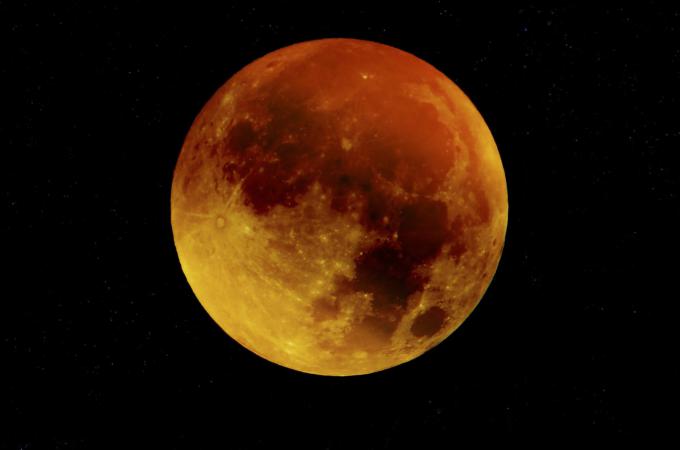The desolateness, and fairness, of the moon
As the 50 year anniversary of the first moon walk approaches, it's not too early to begin reflecting upon the moon. Hollywood, our culture's Baptist, has already sent a movie as a forerunner, "First Man."
But the moon has appeared to humanity both as desolate and as entrancingly fair. From the point of view of human power, it is desolate; and from the point of view of childlike faith, it is lovely. And here is a lesson about faith and providence.
First, the moon as desolate. Buzz Aldrin, the "second man," could hardly keep the phrase out of his mind -- "it is magnificent desolation!" he exclaimed -- and later he gave that title to his memoir. Yet when he went on to explain the "magnificent" part of it, he mentioned everything except the moon: the marbled white-and-blue earth in the sky; the blackness of space; the gleaming perfection of the lunar module which had landed them safely there.
But as for the moon itself, it was desolate, "more desolate than anything on earth," he would say. But how so? Consider that whatever we see on earth has been affected by life. The molecules in the Antarctic ice, for example, were once inside the lungs of animals or in the pores of plants. The deserts, as we know, were once forests, and their rocks carry fossils to prove it. Although we say that areas of earth are "inhospitable to life," still, microbes grow there, or at least they cling to life, dormant. One cannot look anywhere on earth and not sense the potential for life. In that sense the earth is "our common home;" it is meant for life.
But nothing on the moon has ever been touched by life, in the 4.5 billion years since it was formed. The astronauts found the surface of the moon to be covered with fine powder, like talc, "lunar dust." Scientists actually don't understand where this dust came from, perhaps, it is thrown off somehow from meteors when they strike. But it coats the surface and sits there and has been there for billions of years. It has absolutely no connotation of life. The dust was not produced for life; in no sense is it the waste product of life. Where there is no life, there is no purpose, adaptation, or design. Why is the dust there? On the moon, there is a desolateness of purpose too: there is no reason why it is there. If you will, lunar dust is absurd.
But we were not meant to be there, walking on this dust on the surface of the moon; at the same time, we were not trespassing, because nothing else was meant to be there. The nothingness there makes it easy, accordingly, to generalize. Quick: what is 400 billion x 100 billion x 0? But there are 400 billion galaxies, and a 100 billion stars in each. Suppose that any star is like the moon in desolation: then it all adds up to nothing. The supposed impressiveness of space, then, which people say makes us seem like nothing? Compared to even a single living being, it turns out to be no different from the impressiveness of a vacuum.
Probably nature was not meant to be seen in that way. Seeing the moon from its surface is like looking backstage during a show. It's fairly obvious, on the other hand, how the moon was meant to be seen. Just go outside and take a look. It's the same moon in which a child sees a face. Or which lovers call "their" moon. It's the blood red moon rising over a city on a hot summer evening. It's even a magnificent moon, with its brilliant light, seemingly divine. "The moon shines with a borrowed light," a very ancient philosopher (that is, a scientist) once said. This could be seen, the sage said, from the fact that the bulge of the crescent of a moon invariably looks toward the sun.
There was something right about the cleric who refused to look into Galileo's instrument of power. Did we really begin to see the moon when we invented our telescopes, or really begin to lose sight of it? His refusal had a good meaning: "Please, allow the moon to shine, unperturbed, in its other-worldly purity." And today we can join him in part and say: "At least, let's not always be peeking backstage."
There has always been something mysterious about the moon. It turns exactly as it revolves, so, one side is always hidden. "Only in the mystery of the incarnate Word does the mystery of man become manifest," the Council Fathers said. They set down the principle, then, that only in a mystery is a mystery illuminated. But note that they use the language precisely of "the incarnate Word," as if it is the word becoming flesh which is decisive. Thus, the mystery which illuminates man includes Mary and the Holy Spirit illuminating her.
This simple moon, this child's moon, has perennially been thought by Christians to image Mary, who "shines with a borrowed light" because she is not divine, but "magnifies" God in her soul by reflecting his glory, as she turns always towards him.
It's up to us. We can look up into the night sky and see solely the desolation of sterile dust. Or with the eyes of a child we can discern "the mother of all the living."
- Michael Pakaluk is Professor of Ethics and Social Philosophy in the Busch School of Business at The Catholic University of America. His book on the gospel of Mark, ‘‘The Memoirs of St. Peter,’’ is available from Regnery Gateway.



















